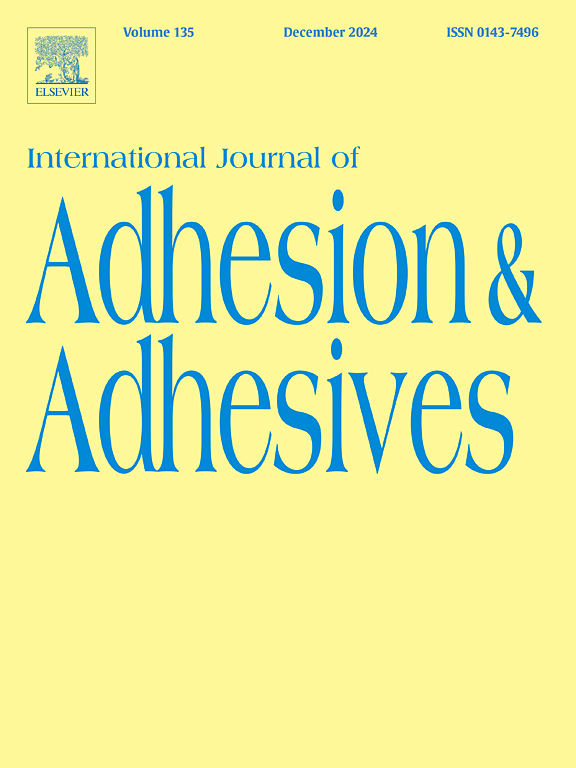The influence of filler types and content on the curing behavior and properties of a bio-based polyurethane engineered sealant
IF 3.2
3区 材料科学
Q2 ENGINEERING, CHEMICAL
International Journal of Adhesion and Adhesives
Pub Date : 2024-10-22
DOI:10.1016/j.ijadhadh.2024.103866
引用次数: 0
Abstract
Polyurethane (PU) sealants are widely used in practical projects to fill road cracks, extend road life and increase the strength of construction joints. And the fillers not only reinforce the sealant, but also effectively reduce costs. In this paper, a series of experiments were carried out to investigate the effects of filler types and contents on the curing behavior and properties of a novel bio-based PU sealant. Firstly, the optimum filler type was determined by fluorescence microscopy (FM) test and physical properties test. The dispersion of different fillers of different contents in the sealant and its effect on the mechanical properties were determined. Secondly, the effect of fillers on the curing behavior was investigated using Fourier transform infrared spectroscopy (FTIR), gel time experiment and surface drying time experiment. The cross-section surface micro-morphologies of the specimens after tensile tests were analyzed by scanning electron microscopy (SEM). Finally, the viscoelasticity and low-temperature properties were determined using dynamic mechanical analysis (DMA). The high-temperature properties of sealant were investigated using thermogravimetric (TG) analysis. The results showed that precipitated calcium carbonate (PCC) was the best filler. Moreover, fumed silica (FS), as a reactive filler, significantly influences the performance of the sealant. With the increase of filler content, the mechanical and high temperature properties of the sealant were enhanced. And the curing process was accelerated. But the low-temperature performance was reduced. Besides, excessive amount of PCC was worse to its uniform dispersion in the sealant and lead to defections in the materials, reducing the strength of the sealant. The optimum PCC content was recommended to be 10 wt%.
填料类型和含量对生物基聚氨酯工程密封胶固化行为和性能的影响
聚氨酯(PU)密封胶在实际工程中被广泛用于填补路面裂缝、延长路面使用寿命和增加施工缝强度。而填料不仅能加固密封胶,还能有效降低成本。本文通过一系列实验研究了填料类型和含量对新型生物基聚氨酯密封胶固化行为和性能的影响。首先,通过荧光显微镜(FM)测试和物理性能测试确定了最佳填料类型。还测定了不同含量的填料在密封胶中的分散性及其对机械性能的影响。其次,利用傅立叶变换红外光谱(FTIR)、凝胶时间实验和表面干燥时间实验研究了填料对固化行为的影响。通过扫描电子显微镜(SEM)分析了拉伸试验后试样的横截面表面微观形态。最后,利用动态力学分析(DMA)测定了粘弹性和低温性能。使用热重分析法(TG)研究了密封胶的高温性能。结果表明,沉淀碳酸钙(PCC)是最好的填料。此外,气相二氧化硅(FS)作为一种活性填料,对密封胶的性能也有显著影响。随着填料含量的增加,密封胶的机械性能和高温性能都得到了提高。固化过程也加快了。但低温性能有所降低。此外,过量的 PCC 会影响其在密封胶中的均匀分散,并导致材料缺陷,降低密封胶的强度。建议最佳的 PCC 含量为 10 wt%。
本文章由计算机程序翻译,如有差异,请以英文原文为准。
求助全文
约1分钟内获得全文
求助全文
来源期刊

International Journal of Adhesion and Adhesives
工程技术-材料科学:综合
CiteScore
6.90
自引率
8.80%
发文量
200
审稿时长
8.3 months
期刊介绍:
The International Journal of Adhesion and Adhesives draws together the many aspects of the science and technology of adhesive materials, from fundamental research and development work to industrial applications. Subject areas covered include: interfacial interactions, surface chemistry, methods of testing, accumulation of test data on physical and mechanical properties, environmental effects, new adhesive materials, sealants, design of bonded joints, and manufacturing technology.
 求助内容:
求助内容: 应助结果提醒方式:
应助结果提醒方式:


